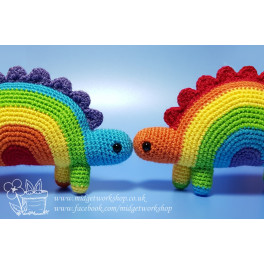Rainbowsauruses
Crochet will find a way!!
What's better than a rainbow and a dinosaur? A dinosaur that is a rainbow!!
Having learnt several important lessons from Jurassic Park, all of our Rainbowsauruses have been created using a combination of dino DNA and yarn; none of that pesky frog DNA that has caused so much trouble in the past! Thanks to this, not only are our dinos more docile, but at approximately* 210mm long, 110mm tall, and 50mm wide they are also the perfect size to hug and take on tiny adventures. They are all herbivorous, but do seem to have a taste for the odd sock here and there, and have also been known to savage dust bunnies. They especially like having a little nest of socks to snuggle into, but also love hugs, playing on computers, and going on adventures. They harbour a huge distrust of open, bath-like water and also of vacuum cleaners. Like many little creatures, Rainbowsauruses have big feelings; be sure you make 'bom, bom, bom, bom' noises when they walk to let them know you recognise their impressively huge ancestry and they will love you forever. Although their disposition is innately happier than other dinos in the same yarny genus, thanks to their rainbow colouring, they do seem to maintain the same levels of pesk. This means that training with the patented 'Dino Clicker' method is just as tricky as with their other yarny cousins, as they are equally easily distracted by everything. We have decided to continue to believe this is part of their charm. Each Rainbowsaurus is grown to order (we take population control very seriously; our supply of socks isn't inexhaustible, after all), with an incubation period of 1 - 2 weeks.
As well as the ground-breaking work in dino genetics completed by Dr Henry Wu, this particular genus of Rainbowsaurus couldn't have been created without the design talents of Irene Strange. Her wonderful pattern is used with her very kind permission, and can be found here should you wish to dabble in dino genetics yourself.
*All Rainbowsaurus measurements are approximate as it's difficult to keep them still long enough to measure them accurately. Also, due to their complex care needs, we recommend that these dinos should not be adopted by anyone under the age of 3.






